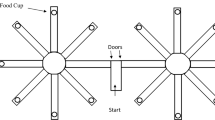Abstract
The effect of physostigmine (0.2 mg/kg), scopolamine (0.1 mg/kg), d,l-amphetamine (1 mg/kg), apomorphine (0.05 mg/kg), and piracetam (100 mg/kg) on working memory was examined in 12 rats that were highly overtrained in the radial maze. In experiment 1, drugs administered 10 min before the trial did not worsen performance of rats in the 12-arm maze. In experiment 2, insertion of a 5-min delay between the sixth and seventh choices increased the number of errors over choices 7–12. Performance was unaffected by pretreatment with physostigmine or apomorphine, but was significantly impaired by scopolamine, amphetamine, and piracetam. In experiment 3, performed in a 24-arm maze, the number of errors and trial duration increased, but performance was not decreased by amphetamine or piracetam. It is concluded that the uninterrupted radial maze task is relatively resistant to pharmacological disruption, but that scopolamine, amphetamine, and piracetam enhance the effect of stimuli interfering with the storage of spatial information over delays.
Similar content being viewed by others
References
Alpern HP, Marriott JG (1973) Short-term memory: Facilitation and disruption with cholinergic agents. Physiol Behav 11:571–575
Blackman DE, Sanger DJ (eds) (1978) Contemporary research in behavioral pharmacology. Plenum, New York London
Bureš J, Bohdanecký Z, Weiss T (1962) Physostigmine-induced hippocampal theta activity and learning in rats. Psychopharmacologia 3:254–263
Burešová O (1980) Spatial memory and instrumental conditioning. Acta Neurobiol Exp 40:51–65
Burešová O, Bureš J (1976) Piracetam-induced facilitation of interhemispheric transfer of visual information in rats. Psychopharmacologia 46:93–102
Burešová O, Bureš J, Bohdanecký Z, Weiss T (1964) Effect of atropine on learning, extinction, retention, and retrieval in rats. Psychopharmacologia 5:255–263
Burešová O, Škopková J (1980) Vasopressin analogues and spatial short-term memory in rats. Peptides 1:261–263
D'Amato MR (1973) Delayed matching and short-term memory in monkeys. In: Bower GH (ed) The psychology of learning and motivation: Advances in research and theory, vol 7. Academic, New York, pp 227–269
Eckerman DA, Gordon WA, Edwards JD, MacPhail RL, Gage MY (1980) Effects of scopolamine, pentobarbital, and amphetamine on radial arm maze performance in the rat. Pharmacol Biochem Behav 12:595–602
Giurgea C (1972) Vers une pharmacologie de l'activité intégrative du cerveau. Tentative de définition du concept nootrope en psychopharmacologie. Actual Pharmacol (Paris) 25:115–116
Giurgea C, Salama M (1977) Nootropic drugs. Prog Neuropsychopharmacol 1:235–247
Heise GA, Conner R, Martin RA (1976) Effect of scopolamine on variable interval spatial alternation and memory in the rat. Psychopharmacology 49:131–137
Hunter WS (1913) The delayed reaction in animals and children. Behav Monogr 2:1–86
Konorski J (1959) A new method of physiological investigation of recent memory in animals. Bull Acad Pol Sci (Biol) 7:115–117
Kramis R, Vanderwolf Ch, Bland BH (1975) Two types of hippocampal rhythmical slow activity in both the rabbit and rat: Relations to behavior and effects of atropine, diethylether, urethane and pentobarbital. Exp Neurol 49:58–85
Lidbrink P (1974) The effect of lesions of ascending noradrenaline pathways on sleep and waking in the rat. Brain Res 74:19–40
Magni S, Krekule I, Bureš J (1979) Radial maze type as determinant of the choice behavior of rats. J Neurosci Lett 1:343–352
Mindus P, Cronholm B, Levander SE, Schalling D (1976) Piracetam-induced improvement of mental performance. Acta Psychiatr Scand 54:150–160
O'Keefe J, Nadel L (1978) Hippocampus as a cognitive map. Clarendon, Oxford
Olton DS (1977) Spatial memory. Sci Am 236:82–98
Olton DS, Becker JT, Handelmann GE (1979) Hippocampus, space and memory. Behav Brain Sci 2:313–322
Olton DS, Collison C, Werz MA (1977) Spatial memory and radial arm maze performance of rats. Learn Motiv 8:289–314
Olton DS, Feustle WA (1980) Hippocampal function required for nonspatial working memory. Exp Brain Res 41:380–389
Olton DS, Samuelson RJ (1976) Remembrance of places passed: Spatial memory in rats. J Exp Psychol (Anim Behav) 2:97–116
Olton DS, Walker JA, Gage FH (1978) Hippocampal connections and spatial discrimination. Brain Res 139:295–308
Olton DS, Werz MA (1979) Hippocampal function and behavior: Spatial discrimination and response inhibition. Physiol Behav 20:597–605
Robinson TE, Vanderwolf CH, Pappas BA (1977) Are the dorsal noradrenergic bundle projections from the locus coeruleus important for neocortical or hippocampal activation? Brain Res 138:75–98
Thompson T, Dews PB (1977) Advances in behavioral pharmacology, vol 1. Academic, New York San Francisco London
Vanderwolf CH (1975) Neocortical and hippocampal ativation in relation to behavior: Effects of atropine, eserine, phenothiazine, and amphetamine. J Comp Physiol Psychol 88:300–323
Author information
Authors and Affiliations
Rights and permissions
About this article
Cite this article
Burešová, O., Bureš, J. Radial maze as a tool for assessing the effect of drugs on the working memory of rats. Psychopharmacology 77, 268–271 (1982). https://doi.org/10.1007/BF00464578
Received:
Accepted:
Issue Date:
DOI: https://doi.org/10.1007/BF00464578




